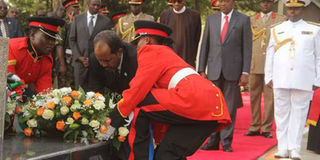Lingering questions a year after deadly attack on Kenyan troops

Somali President Hassan Sheikh Mohamud lays a wreath at Moi Barracks in Eldoret on January 27, 2016 in honour of KDF soldiers killed in El-Adde, Somalia on January 15, 2016 by Shabaab militants. PHOTO | FILE | NATION MEDIA GROUP
What you need to know:
- For several hours, Kenyan troops pinned down by heavy weaponry and artillery bombardments could not defend the camp perimeters.
- One year later, the military is still investigating what transpired on that fateful day.
- KDF spread the burial of the fallen soldiers over several months so that journalists could “lose interest” covering the burial ceremonies and the public tired from following.
Sunday marks the first anniversary of the Battle for El-Adde, where Kenyan troops were ambushed by al-Shabaab militants, leading to one of the heaviest defeats in modern peace operations.
The Officer Commanding the Kenya Defence Forces camp — operating under the African Union Mission in Somalia — was Major Geoffrey Obwoge of the Eldoret-based 9KR Battalion.
There were at least six officers under him drawn from military intelligence, infantry battalions and other support units.
The officers were Captain JM Gichuhi, Captain Elly Amoit Etyang’, a Captain Wachira, Lieutenant Victor Owino, Lieutenant Joe Murimi Kaaria, Lieutenant Steve Orimba and Lieutenant Martin Nthiga. Only Lt Orimba made it back home. To date, KDF has not revealed the number of those who died, leaving a vacuum that has been filled by speculative figures ranging from 80 to 200.
Accounts of the attack differ but it is generally acknowledged that it started with the explosion of Vehicle Borne Improvised Devices (VBIED), which the militants had previously used against other Amisom forces with devastating results.
For several hours, Kenyan troops pinned down by heavy weaponry and artillery bombardments could not defend the camp perimeters.
By the time a search and rescue team of KDF special forces arrived, many Kenyan soldiers at the camp had been killed, but there also emerged stories of valour.
One year later, the military is still investigating what transpired on that fateful day. Who was to blame? Did the survivors reveal everything they knew?
Was the commander at fault? Was there anything which could have been done to avert the attack or reduce the numbers of the fallen? Did the weapons fail?
We might never know how many men died
The siege at El-Adde caused a major embarrassment to KDF which, for years, maintained the smallest number of casualties in the operation against Somali militants.
Since the attack, the Kenya Government has never revealed how many soldiers died and multiple sources, who spoke in confidence, say instructions were issued that no soldier should discuss El-Adde attack.
According to senior military officers, KDF spread the burial of the fallen soldiers over several months so that journalists could “lose interest” covering the burial ceremonies and the public tired from following.
The exact number of the soldiers who crossed over to Somalia is yet to be known. How many died or survived the El-Adde attack remains a mystery.
After the attack, Defence Secretary Raychelle Omamo said that “a company size team” was attacked – meaning 80 to 250 soldiers, according to KDF formations.
What happened to the board of inquiry?
Every time an officer dies in war, KDF constitutes a Board of Inquiry (BOI) to investigate the nature and cause of death and to give a report.
At El-Adde, KDF did not just lose one officer but seven and a camp was run down.
The Chief of Defence Forces, General Samson Mwathethe, promised that a Board of Inquiry was constituted. There has never been any information on the findings of the Board of Inquiry.
Were all key equipment working?
Interviews with survivors and multiple military sources leave a lingering question: were there delays in supplying spare parts, stalling an Armoured Personnel Carrier and two trucks that could have been used to counter the terrorists?
Why did it take long for help to arrive?
One of the strange happenings during the siege is that the first KDF elite troops to arrive at the El-Adde made it in about 48 hours. By that time, al-Shabaab militants had burnt the camp to ashes, carted away weapons and ammunition, and planted their flags at the camp. This was largely blamed on lack of air support by Amisom and delays by KDF to deploy helicopters.
Intelligence of a possible attack
The Department of Military Intelligence is said to have given prior warnings of an attack but this was too broad to be acted upon.
Soured relationship between Somali national army and KDF
The battle for El-Adde soured the relationship between the Kenyan military and the Somali National Forces (SNA).
Intelligence reports indicate that SNA forces who lived at a nearby camp were suspected of having “betrayed” their Kenyan counterparts by fleeing the camp before the Kenyans were ambushed.
Fate of prisoners of war
Al-Shabaab captured some troops from their camp. To date, their families have not received any information on their whereabouts.
Those captured include Leonard Maingi and Jonathan Anunda but the militants, in their propaganda videos whose authenticity cannot be independently verified, claim there are other soldiers held captive
Did heads roll after the attack?
Months after the attack, the President carried out a military reshuffle of top KDF officers. However, to date, it remains unclear if any officer has been held responsible for not doing enough to either avoid the attack or minimise casualties. Military camps are not just overrun. Such happenings could be as a result of a series of systematic failures.




